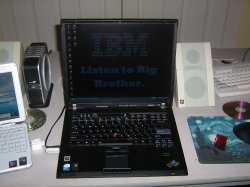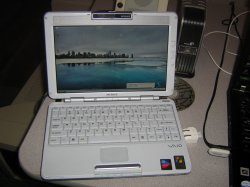artic5693 said:
The Mac Pro can accomodate up to 32 GB of RAM.
The
Mac Pro page on the Apple website claims only 16GiB, as do the options when you customize & buy a Mac Pro.
RevToTheRedline said:
I don't really see how 64GB of ram works in the Dell like it says.
I'm not sure how it works, but I'm pretty sure it does work if they advertise & sell it!
RevToTheRedline said:
64GB of ram or not it still doesn't have OS X
That is hardly the focus of the discussion here, not to mention a very poorly constructed argument in favour of the Mac Pro.
ill0gical0ne said:
Wtf would you ever use 64GB of ram for? Processors aren't fast enough to even utilize that much, and would therefore just become bottlenecked. Instead of spending $11,000 on ram, I'd rather have an xgrid of 4-5 Mac Pros.
It depends entirely upon application. If you are loading a large file into RAM (upon which you will subsequently work) you require virtually no processing power whatsoever & performance is reliant upon hard drive throughput & RAM capacity. Imagine trying to load a raw 1080i film reel into RAM so that you can edit it; if we assume a resolution of 1920*1080 at 16 bits per pixel at 24fps, then a 2-hour film would be around 667GB. Even at just 8bpp we're still talking 320GB. Once it has been loaded, RAM capacity & hard drive performance will solely govern how responsive the machine is when moving through the reel. It's only once you start applying filters/edits that processing power is brought into the equation.
To give another example where this much RAM would be fully utilised, imagine simulating/synthesizing a complex chip, such as a new multi-core microprocessor, using HDL (Hardware Description Languages). You would soon find yourself consuming humongous quantities of RAM.
There are many more examples that you can look into if you're interested, such as high-resolution biomolecular modelling, running a many-client VM server, etc.
Tucom said:
You seem to be quite an advocate of Linux. Which do you prefer, and why?
I definitely prefer Linux over both Windows & OS X (I don't have enough experience in BSD & Solaris to really bring them into the comparison). Windows lacks stability & security, Linux often lacks 'polish'/'finish' & simplicity, & OS X lacks functionality & limits productivity. I'm sure I'll get attacked for that last remark, so I will quickly explain.
In moving from Linux to OS X I found that everything was taking me longer to do, primarily because of simple things, such as the window manager;
- the way new Finder windows open on top of each other & have to be relocated before they can be used instead of automaticlly locating in empty space
- the way that windows can only be resized from the bottom-right corner so if a window is already situated in the bottom-right of the screen it needs to be dragged further upwards/left before I can make it larger
- the lack of a single keyboard shortcut to cycle through ALL windows of ALL applications
- the lack of any keyboard shortcut (including Expose) to cylce through minimised windows
- in regards to Expose, if I have 2 windows that appear left & right when I press [F9], why does it highlight the right window first when I press left?
- the lack of a 'maximise' button for amny applications
- the lack of window snapping
- when a dialogue box appears with two buttons, why do the arrow keys not cycle between the buttons?
- etc.
It is OS X's focus on visually-impressive control over assets that may appeal to many users, as it is a far more intuitive interface, but in terms of raw speed & productivity, other window managers are far superior.
Among other things that I really miss from Linux are a run dialogue, to run any command in the PATH (though Quicksilver comes some way towards achieving this, if at the expense of 50+MB of RAM & installing a third-party application) as well as a
package manager. People who have never used a package manager probably won't realise quite how wonderful they are for centralising installation/uninstallation/upgrades/repairs/etc. of every single app installed on the machine, as well as the base OS itself.
Ignoring the physcailly non-standard keyboard (as that wouldn't be in line in a discussion about operating systems), I also dislike the lack of uniform text-editing shortcuts in OS X, which is another large annoyance to me; in some applications I press [command]+[arrow] to move to the next word, in others it is [ctrl]+[arrow], in others it is [alt]+[arrow]. In some applications [home] will take me to the beginning of the buffer, in others it will take me to the beginning of the current line, etc. Other operating systems manage to provide a standard across all applications, hail they from the OS developer or a third party.
Of course there are features of OS X that I prefer over their counterparts in Linux, however in a comparison of the operating systems as a whole, I would have to give the number one spot to a favorite distribution of Linux.









 OSX that I can find.
OSX that I can find.